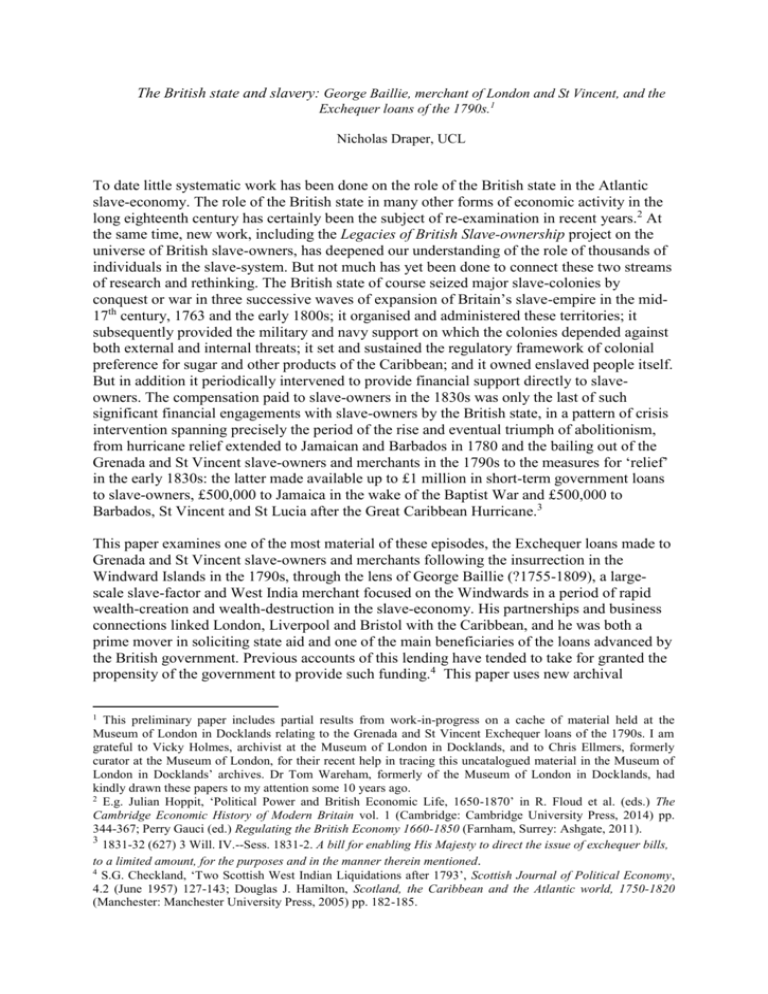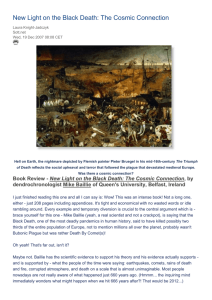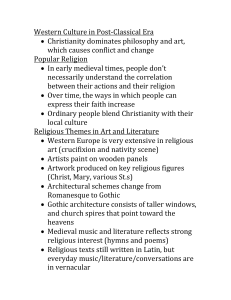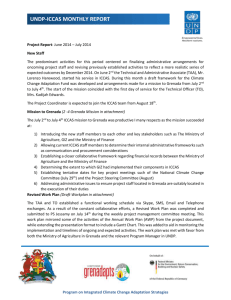The British state and slavery: George Baillie, merchant of London
advertisement

The British state and slavery: George Baillie, merchant of London and St Vincent, and the Exchequer loans of the 1790s.1 Nicholas Draper, UCL To date little systematic work has been done on the role of the British state in the Atlantic slave-economy. The role of the British state in many other forms of economic activity in the long eighteenth century has certainly been the subject of re-examination in recent years.2 At the same time, new work, including the Legacies of British Slave-ownership project on the universe of British slave-owners, has deepened our understanding of the role of thousands of individuals in the slave-system. But not much has yet been done to connect these two streams of research and rethinking. The British state of course seized major slave-colonies by conquest or war in three successive waves of expansion of Britain’s slave-empire in the mid17th century, 1763 and the early 1800s; it organised and administered these territories; it subsequently provided the military and navy support on which the colonies depended against both external and internal threats; it set and sustained the regulatory framework of colonial preference for sugar and other products of the Caribbean; and it owned enslaved people itself. But in addition it periodically intervened to provide financial support directly to slaveowners. The compensation paid to slave-owners in the 1830s was only the last of such significant financial engagements with slave-owners by the British state, in a pattern of crisis intervention spanning precisely the period of the rise and eventual triumph of abolitionism, from hurricane relief extended to Jamaican and Barbados in 1780 and the bailing out of the Grenada and St Vincent slave-owners and merchants in the 1790s to the measures for ‘relief’ in the early 1830s: the latter made available up to £1 million in short-term government loans to slave-owners, £500,000 to Jamaica in the wake of the Baptist War and £500,000 to Barbados, St Vincent and St Lucia after the Great Caribbean Hurricane.3 This paper examines one of the most material of these episodes, the Exchequer loans made to Grenada and St Vincent slave-owners and merchants following the insurrection in the Windward Islands in the 1790s, through the lens of George Baillie (?1755-1809), a largescale slave-factor and West India merchant focused on the Windwards in a period of rapid wealth-creation and wealth-destruction in the slave-economy. His partnerships and business connections linked London, Liverpool and Bristol with the Caribbean, and he was both a prime mover in soliciting state aid and one of the main beneficiaries of the loans advanced by the British government. Previous accounts of this lending have tended to take for granted the propensity of the government to provide such funding.4 This paper uses new archival 1 This preliminary paper includes partial results from work-in-progress on a cache of material held at the Museum of London in Docklands relating to the Grenada and St Vincent Exchequer loans of the 1790s. I am grateful to Vicky Holmes, archivist at the Museum of London in Docklands, and to Chris Ellmers, formerly curator at the Museum of London, for their recent help in tracing this uncatalogued material in the Museum of London in Docklands’ archives. Dr Tom Wareham, formerly of the Museum of London in Docklands, had kindly drawn these papers to my attention some 10 years ago. 2 E.g. Julian Hoppit, ‘Political Power and British Economic Life, 1650-1870’ in R. Floud et al. (eds.) The Cambridge Economic History of Modern Britain vol. 1 (Cambridge: Cambridge University Press, 2014) pp. 344-367; Perry Gauci (ed.) Regulating the British Economy 1660-1850 (Farnham, Surrey: Ashgate, 2011). 3 1831-32 (627) 3 Will. IV.--Sess. 1831-2. A bill for enabling His Majesty to direct the issue of exchequer bills, to a limited amount, for the purposes and in the manner therein mentioned . 4 S.G. Checkland, ‘Two Scottish West Indian Liquidations after 1793’, Scottish Journal of Political Economy, 4.2 (June 1957) 127-143; Douglas J. Hamilton, Scotland, the Caribbean and the Atlantic world, 1750-1820 (Manchester: Manchester University Press, 2005) pp. 182-185. material at the Museum of London in Docklands, together with Baillie’s own polemical pamphlets written in the early 1800s after his business had foundered, to re-explore this government support of slave-owners and merchants in the 1790s, and to reconstruct Baillie’s private and public trans-Atlantic networks (especially his credit networks).5 It aims to shed new light on the relationship between the British state and slavery, to raise questions about the meaning of the co-existence of large-scale state support for slave-owners with the culture of abolitionism, to demonstrate the extent to which ‘the market’ was embedded in the frameworks of the imperial state, and to add to the evidence for the inter-relationship between slavery in the Caribbean and the development of credit networks and credit institutions in Britain. George Baillie George Baillie was a cousin of the Baillie family of Dochfour and Bristol, members of whom were deeply embedded in the slave-economy over two generations.6 George Baillie was unusual in the family in that he left a series of public letters and a pamphlet Narrative of his business affairs, and that he ultimately failed.7 He had gone to the Caribbean in the early 1770s as a young man, became a partner in a series of local merchant firms and ‘had done a great deal of business in the sale of African cargoes, which was much connected with drawing bills for the proceeds on James Baillie & Co. at long sights.’ After upwards of 20 years in the West Indies, he arrived in England August 1793. He was the founder and ‘uncontrouled manager’ of both the successive houses of G. Baillie & Co. 8 The first of these was the partnership carried on as West India merchants for some years in London between Geo. Baillie, Nathaniel Snell, John Turing, Robert Lang, and Eric Mackay (Lord Reay) under George Baillie & Co., which was dissolved acrimoniously on 30/04/1800, with the accounts settled at the firm’s counting house at Finsbury Square.9 The second was a partnership with John Jaffray, again trading as Messrs George Baillie & Co., which was finally declared bankrupt in 1806 after several years of financial instability from 1803.10 5 The papers at the Museum of London in Docklands are labelled Exchequer Bills for Relief of Persons Trading with Grenada And St Vincent BA 2182 Box 678, BA 2183 Box 680 and Boxes 679 and 681-682; George Baillie, Narrative of the Mercantile Transactions of the concerns of George Baillie & Co.’s Houses from the year 1793 to 1805 inclusive. (Printed by John Booth, London, [1805]); George Baillie, Interesting Letters addressed to Evan Baillie, Esq., of Bristol merchant and Member of Parliament for that Great City and Colonel of the Bristol Volunteers (London: J. Gold, [1809]); George Baillie, Interesting Letters addressed to James Baillie of Bedford Square partner in the House of Baillie, Thornton & Campbell (London: J. Gold, [1809]; George Baillie, Interesting Letters addressed to John Bolton Esq. Of Liverpool, merchant, and Colonel of a regiment of volunteers (London: J. Gold, [1809]). 6 Hamilton, Scotland, the Caribbean, pp. 178-180, 199-201. George Baillie’s cousin Evan Baillie and Evan’s son James Evan Baillie were both West India merchants and together with Evan’s other son Peter were partners in Bristol Old Bank; Evan, James Evan, Peter and Evan’s brother James of Bedford Square were all MPs. 7 The pamphlets exist of course because of that failure. The higher survival rate of records of financial collapse tends to push the historiography towards instances of failure rather than success in the slave-economy, e.g. R.B. Sheridan, ‘The West India Sugar Crisis and British Slave Emancipation, 1830-1833’, Journal of Economic History 21.4 (December 1961) 539-551; and Checkland, ‘Two Scottish West Indian Liquidations.’ While George Baillie died a bankrupt, Evan Baillie left £80,000 excluding his Scottish land in 1835 and his son James Evan Baillie left over £100,000 in personalty plus extensive Scottish estates in 1863. 8 Baillie, Narrative, pp.iii.. 9 London Gazette, 15254 05/03/1800 p. 436. 10 London Gazette, 15973 08/11/1806 p. 1471. What was his business in London? As Baillie said of his first London firm, it did not require cash, only capital: ‘The nature of our business did not require advance, but a great responsibility was necessary, it was guaranteeing the sale of African cargoes.’11 He was not a slave-trader in the sense captured in the Trans-Atlantic Slave-Trade Database, but a slavefactor in the Caribbean and then a financier of the slave-trade in London. This whole nexus of slave-factoring sits outside the perimeter of the Trans-Atlantic Slave-Trade Database (where George Baillie is not identified) but was crucial to the structure of the slave-economy and remains crucial to the Williams’ thesis that credit networks and institutions in Britain gained from the credit-intensity of the slave-trade.12 Baillie illustrates Jacob Price’s thesis about the importance of the merchant as a credit-provider in the colonial Atlantic, even at the end of the 18th century.13 As Price pointed out, there were two sets of bills, those issued by the slavefactor to the captain of the slave-trader and drawn on (payable by) the London guarantor; and the bills issued to the factor by the ‘planters’, the slave-owners who were the purchasers of the enslaved and sent (consigned) their produce to London to repay directly or indirectly their own bills as they came due. This form of finance fits with Sheridan’s conception of the importance of short-term credit as opposed to the mortgage finance Simon D. Smith rightly reinserted into the picture.14 Both types were necessary: they performed different functions in the slave-economy. It is also clear in Baillie’s account that banks were growing in importance behind the merchant firms: the London banking firm of Smith, Payne & Smith looms in Baillie’s Interesting Letters as a minatory presence.15 Baillie was also a slave-owner, although this appears to have been ancillary to his mercantile activities. At the time of his bankruptcy, he and John Jaffray owned the Sion Hill, Carapan and Carriere estates on St Vincent, a moiety of the Inverness estate in Berbice and ‘a certain portion’ a second estate there, known as the Cannaye Lot: the estates, ‘together with all the Slaves, Plantation Stores and other Live and Dead Stock’ were auctioned off by the assignees in bankruptcy in 1807.16 The Exchequer Loans of the 1790s. The outlines of the story of the Exchequer loans are already known through the work of Checkland and Hamilton. Years of significant buoyancy in the slave-economy in Grenada and St Vincent - in his will proved in 1793, George Baillie’s cousin James Baillie of Bedford Square said he had ‘sometime since’ paid a barely credible £100,000 for the Bacolet and Chemin estates on Grenada17 - came to a halt with the outbreak of Fedon’s rebellion on 11 Baillie, Narrative, p. 6. This thesis has recently been given fresh support, e.g. Pat Hudson ‘Slavery, the slave trade and economic growth: a contribution to the debate’ in C. Hall, N. Draper, K. McClelland (eds.) Emancipation and the remaking of the British imperial world (Manchester University Press, 2014), pp. 36-59. 13 Jacob M. Price, ‘What did merchants do? Reflections on British Overseas Trade 1660-1790’, Journal of Economic History XLIX No. 2 The Tasks of Economic History (June, 1989), pp. 267-284. 14 S. D. Smith, ‘Merchants and planters revisited’, Economic History Review, LV 3 (2002) pp. 434-465. 15 Baillie, Evan Baillie, p. 76. 16 London Gazette 15591 13/01/1807 p. 55. 17 PROB 11/1237/227. 12 Grenada in the context of wider war with Revolutionary France. The disruption of production halted the flow of produce to Britain and left the metropolitan merchants exposed. Baillie himself said that ‘after great perseverance, and being three times refused, I succeeded in my application to Government for a loan, to the extent of one million and a half, for all the sufferers.’18 Baillie’s own account of the securing of government assistance aid might reasonably be seen as seeking to maximise his role, but in the (undated) sequence he set out, he first met with Dundas and got his support for an immediate meeting with Pitt, in which Pitt said he would ‘take advice.’ Silence followed, so Baillie re-approached Pitt direct through ‘Secretary Mr Smith.’ But Pitt declined to meet - Baillie found that Pitt had taken advice in the city that ‘was adverse to any pecuniary aid’ and so concluded ‘it therefore seemed necessary to address him in more formal manner.’ He went to Sir Richard Neave, chairman of the West India Merchants Committee [but himself a slave-owner in the Leewards rather than the Windwards], and together the two men met Pitt. Again, Pitt demurred ‘lest it might become a very dangerous precedent’ and Neave gave up. Baillie however persisted and convened a meeting of merchants at which Lord Sheffield and Sir William Pulteney attended. Sheffield and Pulteney then met with Pitt, and got agreement the next day, after which the leading merchants met with Dundas and Pitt ‘to arrange it.’ ‘The meeting in fact was merely a matter of form, for Lord Sheffield and Sir William Pulteney had previously settled the point for us…we had only to procure security for the loan from government.’19 Baillie omitted the Parliamentary dimension of this process. On 11/06/1795 a petition of merchants trading to St Vincent and Grenada was referred to a committee, and Royal Assent was given to the bill 27/06/1795, for a total loan of up to £1.5MM.20 A group of Commissioners were established to administer the scheme, whose Secretary, Thomas Marsham, submitted his accounts in 1807.21 Under the Act, repayments of advances were to be made in instalments on 05/01/1797, 10/10/1797 and 05/07/98. Who got the loans? In all, there were 62 loans identified by separate Certificate no. made by the commissioners, totalling £1.367MM.22 Until now, no systematic account of who borrowed under the scheme has (to my knowledge) been possible. It has been known that the two main beneficiaries of the loan were George Baillie himself (variously given as £260,000 or £250,000)23 and Alexander Houstoun & Co. of Glasgow (£240,000). A report of 1800 used by Checkland gives details of two other borrowers in addition to Houstoun & Co. (Charles Ashwell and William Johnstone, relatively modest borrowers of £16,000 and £10,000 respectively) 24, while Hamilton identified Alexander Johnstone, the brother of William Johnstone Pulteney, as borrowing £10,000 to re-establish the Westerhall estate.25 Two sets of Parliamentary 18 Baillie, Evan Baillie, pp. 23-24. Baillie, Narrative pp. 8-10. 20 35 Geo III C. 127. 21 The National Archives, AO 1/888/134. 22 A number of loans have several tranches and some borrowers have more than one Certificate number. 23 Baillie himself gives £260,000: ‘Of this loan, my house had £260,000, which has been long since repaid with interest’, Baillie, Evan Baillie, pp. 23-4. 24 Journals of the House of Commons 55 (1799-1800) 424 (Eighteenth Parliament of Great Britain: fourth session (24 September 1799 - 29 July 1800)) ‘Report On Mr. McDowall's Petition’, &c. &c. 25 Hamilton, Scotland, the Caribbean, p. 183. 19 Papers from 1801 and 1802 provide various analyses of the loan by Certificate number, without identifying the borrowers by name.26 But the recently reviewed papers at Museum of London in Docklands now allow the identification of 75% of the recipients of the Exchequer loans accounting for some 85% of the funds.27 The papers include Certificate nos., borrowers and guarantors. It is not clear why some Certificates are missing from these records. The loan to Alexander Johnstone, identified by Hamilton, for example, has not been found in the papers.28 The bulk of the money went overwhelmingly to ‘merchants’ rather than ‘planters’ (contemporary classifications that from our perspective are not always so clearly distinguished). This was already clear from the 1801 analysis, which showed that £1.01MM went to merchants against £357,000 for ‘planters.’29 To an extent, the picture is coloured by the size of the two largest loans, accounting for half a million pounds between two merchant firms. For Grenada alone, £183,333 6s 8d went to recipients characterised as ‘planters’ and £225,466 13s 4d to ‘merchants’; For St Vincent, £157,800 went to planters, and only £20,000 to merchants. The overall discrepancy in favour of merchants was driven by the weight of the merchants within the combined Grenada and St Vincent category, where only £16,000 went to a planter with estates in both islands whereas £765,000 went to merchants trading to both islands (including George Baillie and Houstoun). What the data at Museum of London in Docklands giving the names of the borrowers shows is the extent to which the ‘planters’ were in fact absentees, rather than living in the islands. Again it is recognised that absentee and resident were malleable categories, status shifting over time. But among the known recipients, of the planters receiving loans, only three are identifiable as resident in the colonies (Burrows, Irwin and Ottley who borrowed £20,000 under Certificates nos. 74 and 140; Thomas Fairbairn of St Vincent who borrowed £2000 under Certificate no. 128; and James Campbell ‘of Tobago’ who borrowed £12,000 under Certificate no. 109). Two were ‘transatlantic’ (Wm Johnstone of Grenada ‘but now in London’ who borrowed £10,000 under Certificate no. 104 and Drewry Ottley under Certificate no. 32 who borrowed £4,500). The remainder were absentee owners, living in Britain and close enough to the process to respond to the opportunities it represented. Among these absentee owners were: Dundas himself, under Certificate no. 130 borrowing £10,000; Sir William Young of Hunterscombe under Certificate no. 40 borrowing £10,000, and the 26 PP 1801 (98) Report on the petition of the proprietors estates in the island of Grenada [printed 01/06/1801] includes as Appendices 27 and 28 [pp.42-45 and 46] different breakdowns of the loan between ‘merchant’ and ‘planter’ and between ‘Grenada’, ‘St Vincent’ and ‘Grenada & St Vincent’; PP. 1801-1802 (43). An Account of the Loans Advanced, in Exchequer Bills and Cash, to the PLANTERS AND MERCHANTS interested in the Islands of Grenada and St Vincent’s: Distinguishing, the Date of the several Advances; the Period at which the same were to be Repaid; with the several Postponements thereof; and, the Amount of the Sums which have been Repaid, with the respective Dates of such Repayments: Dated the 18 th Day of March 1802. 27 The 15 loans not yet identified carry the Certificate numbers 9, 13, 19, 30, 33, 34, 43, 47, 55, 75, 101a and b, 122, 124, 129 and 138. Nine of these were classified as ’planter’ loans and six as ‘merchant’. Together they represent £174,600 of the total loans of £1.367MM: £90,500 in Grenada, £49,100 for St Vincent and a single loan of £35,000 to a currently unknown mercantile recipient for both Grenada and St Vincent. 28 It appears probable that it was Certificate no.43, the only loan of £10,000 for Grenada classified as ‘planter’ or which the recipient has not already been identified. 29 1801 (98) Report on the petition pp. 42-45 and 46. Certificate no. 49 for £2000 is shown inconsistently as in the source as both merchant and planter. It was to Alexander Kenneth Mackenzie of Great Carth Street Cavendish Square, and has been classified as planter for the numbers above. sole woman, the Rt Hon. Susanna Louisa Lady St John, under Certificate no. 93a, again borrowing £10,000. What happened to repayments? Under the terms of the 1795 Act, the final repayments were due on 05/07/1798. In fact, the repayment dates were postponed at least four times, and were ultimately set as March 1804.30 Baillie himself and his partners still had £166,666 13s 4d outstanding under Certificates 1a, 1b 1c and 1d by 18/03/1802, but did eventually repay all the principal and interest. Of the second largest loan, however, the £240,000 to Houstoun & Co., only £4999 4s 5d had been repaid of £240,000 under Certificates 2 a, b, c and d by 1802, and this loan went in to ‘special measures’, along with loans to Charles Ashwell and William Johnstone. The state stepped in and became the liquidator of the Houstoun & Co. firm. The securities or guarantors of the Houstoun firm and the other borrowers appear to have been undisturbed by demands to deliver on the guarantee. Hamilton says that petitions ‘were considered minutely by the [select] committee], then twice by committee of whole house’ before the state agreed to take the three loans out of the Commission and deal with them separately as liquidations.31 What is clear is that House of Commons saw shortcomings in the application of its own rules to these loans: by the Act, estates in Grenada and St Vincent as security were to have been valued at no more than 2x purchase (at twice the annual income) but the report commented that those in St Kitts were valued at 10x purchase at least. In the Ashwell case the only security was the estate itself and even then the executors proposed to subordinate the state loan to other creditors, annuitants etc. Overall, by1802, of £1,367,600 advanced, £528,696 4s 4d had been repaid (together with interest of £181,228 9s 4d) and £260,503 15s 8d withdrawn from the Commissioners and placed in trust. Commercial and credit networks Each recipient of an Exchequer Loan was obliged to provide ‘securities’, guarantors in Britain. There appears to have been some variation in whether the guarantors supported the principal or the ‘penal sum’ pledged by the borrowers themselves, of twice the amount. The identity of these guarantors and the amounts pledged are given for a number of the loans in the papers at the Museum of London in Docklands, and hence allow the reconstruction of networks for the borrowers concerned. George Baillie himself had characterised his supporters as his clients among the slave-traders and that appears to be borne out by the available data for three tranches of the loans to his firm, made to the names of George Baillie, Nathaniel Snell, Robert Lang, John Turing & Eric Mackay. 30 35 Geo III C. 127 [27/06/1795: repayments to be made 05/01/1797; 10/10/1797; 05/07/98]; 37 Geo III C. 27 [30/12/1796: repayments to be made 05/0/1799; 10/10/1799; 05/07/1800]; 39 Geo III C. 11 [04/01/1799: repayments to be made 2/10/1799; 25/03/1800; 25/03/1801]; 39 Geo III C. 11 Sess. 2 C13 [12/10/1799: repayments to be made 05/01/1800; 05/01/1801; 05/01/1802]; 41 Geo III C. 27 [31/12/1800: repayments to be made 05/03/1802, 05/03/1803, 05/03/1804 31 Hamilton, Scotland, the Caribbean, p. 185. Table 1. Securities of George Baillie & Co. for tranche 1B (£180,000 principal) Tranche Guarantor Date 1B 1B 1B Charles Young of Bristol John Anderson of Bristol Thomas Deane of Bristol 18/07/1795 Y 18/07/1795 Y 18/07/1795 Y Bristol Bristol Bristol 10,000 40,000 5,000 1B 1B 1B 1B William Parry the younger Robert Rolleston Richard Miles of America Sq. Edmund Higginson 13/07/1795 13/07/1795 13/07/1795 13/07/1795 Y Y Y Y London London London London 5,000 10,000 10,000 8,000 1B 1B 1B 1B 1B Thomas Earle of Liverpool William Earle of Liverpool John Bolton of Liverpool Joseph Birch of Liverpool Christopher Butler, Francis Ingram, James Rigby of Liverpool Thomas Staniforth, Thomas Parke, John Houghton of Liverpool Jonathan Ratcliffe, Wm Thompson, George Hewitt of Liverpool John Gregson, George Case, John Bridge Aspinall, James Aspinall, William Gregson George Case, Wm. Gregson, John Gregson, Wm. Gregson the younger, Thomas Morland, J.B. Aspinall, James Aspinall Clayton Tarleton, William Rigg of Liverpool 13/07/1795 13/07/1795 13/07/1795 13/07/1795 18/07/1795 Y Y Y Y Y Liverpool 1,100 Liverpool 6,400 Liverpool 10,000 Liverpool 10,000 Liverpool 25,000 Edward Vaux of London and Edward Vaux the younger, insurance brokers John Sime master mariner Mile End Thomas Morton of Clapton Terrace Jacob Wilkinson of City of London merchant Benjamin Hopkinson of Russell Pl. John Wilson of Charlotte St. William Lyttleton of Mansell St. Joseph Partridge Edmund Reynolds of Bath Archibald Alves of Springfield John McConnell of Monmouth 1B 1B 1B 1B 1B 1B 1B 1B 1B 1B 1B 1B 1B 1B 1B 1B Slaver? If so, city Amount £ 13/07/1795 Y Liverpool 4,000 13/07/1795 Y Liverpool 2,400 13/07/1795 Y Liverpool 18,600 13/07/1795 Y Liverpool 12,400 13/07/1795 Y Liverpool 11,000 13/07/1795 N 10,000 13/07/1795 N 13/07/1795 N 13/07/1795 N 400 14,800 10,000 13/07/1795 13/07/1795 13/07/1795 13/07/1795 13/07/1795 13/07/1795 13/07/1795 20,000 10,000 16,000 14,800 20,000 10,000 10,000 N N N N N N N Table 2. Securities of George Baillie & Co. for tranche 1C (£6,000 principal) and identified securities of George Baillie & Co. for tranche 1D (£26,500 principal) Tranche Guarantor Date Slaver? If so, city 1C Duncan Davidson, Henry Davidson 21/07/1795 N 1D 1D 1D 1D 1D Peter Gurley of Earls Court James Harvey of Bristol John Backhouse of Liverpool John Hodgson of Liverpool John Mangles of Wapping ships chandler 30/07/1795 30/07/1795 30/07/1795 30/07/1795 30/07/1795 N Y Y Y Y Amount £ 12,000 Bristol L’pool L’pool London 5,600 5,000 2,800 2,400 6,800 Of the £324,900 identified of securities for the largest tranche 1B under 29 separate guarantees, £188,900 was provided by 18 slave-traders or firms of slave-traders in Bristol, London and Liverpool. Of the £136,000 from those 11 guarantors not identified as slavetraders, two are known to have been slave-owners (Edmund Reynolds of Bath, whose will shows he held enslaved people in Grenada, and Benjamin Hopkinson of Russell Place, who was a major slave-owner in what became British Guiana). Similar networks can (and will be created) for other recipients of the Exchequer loans. The second largest borrower, Alexander Houstoun & co. in the names of William McDowall, James McDowall, Andrew Houstoun and Robert Houstoun Rae, drew on a primarily Scottish network of guarantors. Borrowers also appeared as guarantors: the firm of Duncan Davidson which guaranteed Tranche 1C for George Baillie itself borrowed £50,000 on 6th March 1797.32 Guarantors doubled up, acting as securities for more than one borrower: John Gregson and James Gregson, and John Bridge Aspinall and James Aspinall, pledged £8500 and £4250 respectively in support of the £15,000 loan to Edmund Thornton, James Baillie, Duncan Campbell and John Orr five days after similar pledges in support of George Baillie. Conclusion: what does the episode say about the state and slavery? The issue of Exchequer loans for Grenada and St Vincent has been treated as a relatively prosaic action by the state. Checkland saw the 1800 Act for the Houston liquidation as ‘a unique example of official aid to a particular house’ but was less struck by the Exchequer loans themselves, saying: ‘In 1793 the state had learned to support general credit in the face of short-term disturbance; in 1795 it served a particular group exposed to calamity - the 32 Box 679 Certificate no. 105. Grenada and St Vincent men; in 1799 it supported the Liverpool and Lancaster West India traders (the bank looked after the rest); in 1800 the range of possibilities were completed with the Act covering the case of Houston and Co.’33 Hamilton said of the loans ‘[T]he acquisition of public money appeared to be the only solution.’ But the state did not respond to all, or even most, calls for crisis relief from commercial and propertied interests. Addington later refused George Baillie’s attempt at a general loan for merchants in 1804.34 Earlier, in 1797, in the context of the St Domingue revolution, the London merchant John Turnbull had written unsuccessfully to Henry Dundas to set out the exposure of Turnbull Forbes to Cardinal Rohan’s family, and to seek not money but grants of land to settle their connected house of Bertrand Littledale, from Port-au-Prince to Demerara or Trinidad.35 Hoppit has stressed the local component of the state’s role in the economy: ‘parliament’s supreme legislative power was vigorously used by many thousands of small and scattered property interests’ as opposed to national policies.36 Parliament was in his phrase ‘a use right for propertied society’, a relatively cheap means to reconfigure significant aspects of economic life.37 But the loans were not a permissive action or even necessarily cheap: they incurred direct and substantial risk for the British state. It was a government measure, not a private one. This was surely the equivalent of rent-seeking by a group that could overcome Pitt’s clear reluctance. On this issue, a fragment of the West India lobby prevailed over the Prime Minister’s instincts, and some parliamentary opposition, for opposition there was. On March 13 1802, when the Committee of the whole House debated the report of the Committee on the petition of Grenada and St Vincent planters, William Lushington, the agent for Grenada and himself a beneficiary of the Exchequer loan, said that it had met its objectives with the successful resettling of two colonies. ‘But though the advantage thus reaped by the public had been great, the individuals had gained but little.’ It was normal, he said, to grant more time, and he was seconded by Sir Wm Young, another beneficiary. But reflecting the clear mercantile character of the loan, ‘Sir R. Buxton and Mr Jones thought that in measures of this kind the landed interest was sacrificed’, while Wilberforce protested vigorously against an extension, saying he opposed it not on the basis of subsidising slavery but of subsidising West Indians ‘by the property of the people of England’ when there was ‘no prospect of repayment.’ 38 Part of the explanation for the government’s ultimate willingness to put up risk capital must lie in the background to the upheaval in Grenada. As early as 1793, when Carriacou was cut off, the slave-owners in Grenada had warned of danger externally and from within, and these Checkland, ‘Two West India Liquidations’ p. 132; Hamilton, Scotland, the Caribbean p. 182. Checkland, ‘Two West India Liquidations’ p. 142; 35 Carl Ludwig Lokke, ‘London Merchant Interest in the St. Domingue Plantations of The Émigrés, 1793-1798’, The American Historical Review, Vol. 43, No. 4 (Jul., 1938), pp. 795-802, and ‘New Light on London Merchant Investments in St. Domingue’, The Hispanic American Historical Review, Vol. 22, No. 4 (Nov., 1942), pp. 670676. 36 Julian Hoppit, ‘Political power and British economic life,1650-1870’ in R. Floud, J. Humphries, P. Johnson (eds.) The Cambridge Economic History of Modern Britain, Vol. 1: 1700-1870 (Cambridge: Cambridge University Press, 2014) pp. 344-367, at p. 345. 37 Ibid. p. 365. 38 William Woodfall, An Impartial Report of the Debates that Occur in the Two Houses of Parliament in the Course of the second Session of the First Parliament of the United Kingdom of Great Britain and Ireland Vol. II (London 1802) pp. 89-90. 33 34 warning certainly circulated in London.39 The government’s perceived neglect was later the subject of a Parliamentary inquiry.40 The second factor must have been the power of the individuals conscripted and their direct interest in the matter. The beneficiaries included undistinguished MPs such as Sir John Trevleyan of Nettlecombe, and John Trevanion, but also Dundas himself and the brother of William Johnstone Pulteney. As Hamilton notes, Pulteney, who acted as one of the commissioners in Exchequer loan Office, himself owned Port Royal estate in Grenada and after 1799 Bon Accord in Tobago, while the 1803 committee on St Vincent and Grenada was chaired by Evan Baillie.41 The Exchequer Loan process, in contrast to the 1830s compensation payments, appears to have been characterised by very traditional forms of patronage. When John Peter Hankey’s loan got stuck in 1798, he asked Sir William Curtis to intervene for him with Pitt personally, which Curtis did, although not by seeing him as Hankey had asked but by writing: ‘I entreat you if possible to give some speedy relief.’42 The third explanation of government intervention, the argument of systemic risk, appears to have been applied more over the Houstoun liquidation of 1800 than the original loans of 1795. The Glasgow financial institutions certainly leant in to support an orderly run-down of Houstoun and Co. as ‘a measure of public utility’, as the Glasgow Chamber of Commerce argued. The cashier of Royal Bank of Scotland and the treasurer of the Bank of Scotland endorsed the ‘too big to fail’ argument. Finally, however, the Exchequer loans appear to say something about the salience of slavery in the 1790s. Eric Williams was surely right to focus on Pitt’s apparent shift under the pressures of war towards being persuaded that the Caribbean slave-economies were one of the key battlegrounds with France. The Exchequer loans are consistent with that controversial analysis. The state and slavery in the 1790s were still in the perceived symbiotic relationship that had characterised them before the rise of abolitionism.43 And that could not have changed by 1806-7. In other words, the abolition of the slave-trade needs to be seen more in light of Williams and David Beck Ryden as a means of shoring up the slave-system than as a deliberate blow against it. 39 Chatham Papers, PRO 30/8/127 Pt 2 End 204. Letter from William Curtis at Old South Sea House 17 th October 1793 to Pitt, forwarding as matter of duty a letter from ‘my correspondent the Honourable Thos. Campbell of Grenada…I have likewise sent one to the Earl of Chatham.’ 40 PP 1801 (98) Report on the petition of the proprietors estates in the island of Grenada [printed 01/06/1801]. Appendix 26, p. 41 includes Resolutions of 09/01/1793 Meeting of Gentlemen Planters and Merchants of the Island of Grenada [seeking to make slaves available for defence work]; it was signed by 27 people (and 2 firms: Simond & Hankey and Lushington & Law) including John Julius Angerstein, and James Baillie as Agent, and Wm Curtis. 41 Hamilton, p. 183. 42 Chatham Papers, PRO 30/8/127 Pt 2 End 215 . 43 Julian Hoppit, ‘Bounties, the Economy and the state in Britain, 1689-1800’ in Regulating the British Economy 1660-1850 (Farnham, Surrey: Ashgate, 2011) pp. 139-160. Conclusion ‘There was never any loan granted by government more necessary than the Grenada and St Vincent loan; it has been the saving of these islands, and many of the planters and merchants connected with them, from real distress: the revenue has benefited considerably by the estates being made productive, and government will soon be paid the last farthing, with interest; on the whole, therefore, it has done a wonderful deal of good, beside proving, in every respect, highly creditable to the minister.’44 This was Baillie’s verdict on the loan scheme, which was in reality primarily a mercantile bail-out. Resident planters in the islands received relatively. Proximity to the metropolitan government appears to have been critical. The Exchequer loans form part of a continuous story of responsiveness by the British state to calls for direct relief from merchants and slave-owners in the British Caribbean, from hurricane relief in 178045, through the St Vincent Volcano 181146 to the combined relief of 1831-3247 and the compensation payments to slave-owners for Emancipation of the 1830s. What was the nature of the state’s intervention? Smith saw the ex-post relief as taking the place of insurance or itself representing ex-post insurance.48 But ex-post insurance is insurance when the loss has already been incurred; no premia were ever paid; the state in each case was making a highly-targeted transfer payment to the merchants and slave-owners. Less than 4% of the 1831-1832 lending was ever repaid.49 Few other groups appear to have benefitted so frequently over so long a period from state aid as the slave-owners and merchants. The continuity and regularity of British state reflexes in the face of such requests for assistance needs to be factored into the assessment both of the British state’s role in slavery of slavery’s role in the British state. 44 Baillie, Narrative, p. 12. Matthew Mulcahy, Hurricanes and society in the British Greater Caribbean 1624-1783 (Baltimore: Johns Hopkins University Press, 2005). 46 PP. 1812-13 (182) Report from committee on petition of persons interested in estates in the island of Saint Vincent; S.D. Smith, ‘Volcanic hazard in a slave society: the 1812 eruption of Mt Soufriere in St Vincent’ Journal of Historical Geography, January 2011 37.1 pp. 55-67. The signatories of London petition were Simon Fraser, Houston; Brooke Struth and Rose; John Robley & Co; Jos. Marryat; D.H & J.A. Rucker; Rich. Tho Neave; Lang Chauncy and Lucas; and George Blackman. 47 PP. 1831-32 (627) 3 Will. IV.--Sess. 1831-2. A bill for enabling His Majesty to direct the issue of exchequer bills, to a limited amount, for the purposes and in the manner therein mentioned; S.D. Smith, ‘Storm Hazard and Slavery: The Impact of the 1831 Great Caribbean Hurricane on St Vincent’, Environment and History, Vol. 18 No. 1 (Feb 2012), pp. 97-123. 48 Smith, ‘Volcanic hazard’ p.66; Smith, ‘Storm hazard’, p. 123. 49 Smith, ‘Storm hazard’, p. 102, sourced to PP 1854–55 (159 & 470), p.24. 45







